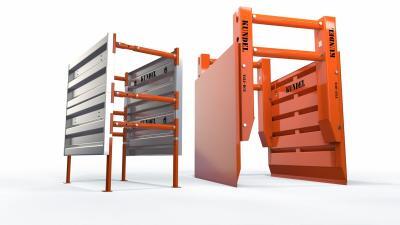What is Jack and Bore?
Jack and Bore is a trenchless method used for installing underground utilities such as pipes, conduits, or cables without the need for traditional open-cut excavation. It is a popular technique employed in construction and civil engineering projects to minimize disruption to the surrounding environment and reduce construction time and costs.
The Jack and Bore method involves the use of hydraulic jacks to push a pipe through the ground while simultaneously removing the soil. Here’s how the process typically works:
- Planning and Preparation: Before starting the Jack and Bore operation, a detailed survey and assessment of the site are conducted. This includes studying the soil conditions, underground utilities, and any potential obstacles that may affect the installation process. The required equipment, including hydraulic jacks, pipes, and excavation machinery, is arranged accordingly.
- Pilot Bore: A small-diameter pilot hole is drilled from one point to another along the desired underground utility route. This is usually achieved using a directional drilling machine or an auger boring machine. The pilot hole serves as a guide for the subsequent pipe installation.
- Enlargement: Once the pilot hole is completed, the next step involves enlarging the hole to accommodate the desired pipe size. This is achieved by using a reaming tool or an auger with an increased diameter, which is pushed through the pilot hole. The reaming process removes the soil, creating a larger bore.
- Pipe Installation: After the hole is sufficiently enlarged, the pipe to be installed is positioned at one end of the bore. Hydraulic jacks are then used to apply force to the pipe, gradually pushing it through the bore while simultaneously removing the excavated soil. The jacks are typically positioned at the entry point and operate in a synchronized manner to provide a controlled and steady push.
- Soil Removal: As the pipe is pushed forward, the excavated soil is either transported back along the annular space between the pipe and the bore wall or removed using appropriate techniques such as slurry pumping or vacuum extraction. The method of soil removal depends on the specific site conditions and the type of soil encountered.
- Completion and Restoration: Once the pipe has been successfully installed, it is inspected for alignment and any necessary adjustments are made. The entry and exit pits are then backfilled, and the surface is restored to its original condition, minimizing the visual impact of the installation.
Jack and Bore offers several advantages over traditional open-cut excavation methods. It reduces the need for extensive digging and minimizes disruption to the surrounding areas, making it suitable for installations in urban or environmentally sensitive locations. Additionally, it is often a more cost-effective option, as it requires less manpower and shorter construction time.
However, it’s important to note that the suitability of Jack and Bore depends on various factors such as soil conditions, pipe size, and the presence of underground obstacles. A thorough site assessment and engineering analysis are necessary to determine if this method is appropriate for a specific project.

Trench Safety Equipment: Trench Boxes Manhole Boxes, Bedding Boxes, Road Plates
Jack and Bore Safety
There are several safety precautions that need to be followed during the Jack and Bore process to ensure the well-being of the workers and the successful completion of the project. Here are some common safety measures:
- Site Evaluation: Conduct a comprehensive site evaluation to identify any potential hazards such as underground utilities, unstable soil conditions, or existing structures that could affect the safety of the operation. This evaluation helps in planning the appropriate safety measures.
- Protective Gear: All workers involved in the Jack and Bore process should wear appropriate personal protective equipment (PPE) including hard hats, high-visibility clothing, safety boots, gloves, and eye and ear protection. PPE requirements may vary depending on the specific site conditions and local regulations.
- Equipment Inspection: Regularly inspect and maintain all equipment used in the Jack and Bore process. This includes hydraulic jacks, drilling machines, reaming tools, and any other machinery involved. Ensure that they are in good working condition and that safety features are functioning properly.
- Trench and Excavation Safety: Although Jack and Bore is a trenchless method, there may still be the need for some excavation for entry and exit pits. If any excavation is required, proper trench safety measures should be followed, including shoring, sloping, or shielding to prevent cave-ins or collapses.
- Underground Utility Detection: Accurate detection and marking of existing underground utilities are crucial to avoid accidental damage during the Jack and Bore process. Use appropriate utility locating methods, such as ground-penetrating radar or utility locating services, to identify and mark the location of buried utilities.
- Ventilation and Air Quality: Depending on the soil conditions and potential presence of gases or vapors, adequate ventilation and air quality monitoring may be necessary. Ensure proper ventilation systems are in place to control the buildup of harmful gases or airborne contaminants in enclosed spaces.
- Training and Supervision: Workers involved in the Jack and Bore operation should receive thorough training on the specific techniques, equipment operation, and safety procedures. They should be supervised by experienced personnel who can oversee the project and address any safety concerns promptly.
- Emergency Response Planning: Develop an emergency response plan that includes procedures for dealing with accidents, injuries, or hazardous situations. This plan should be communicated to all personnel involved in the project, and appropriate emergency contact numbers should be readily available on-site.
It’s important to note that these safety precautions serve as general guidelines, and specific safety protocols may vary based on the project’s location, local regulations, and site-specific conditions. Consulting with safety experts and adhering to industry standards is essential to ensure the highest level of safety during the Jack and Bore process.

